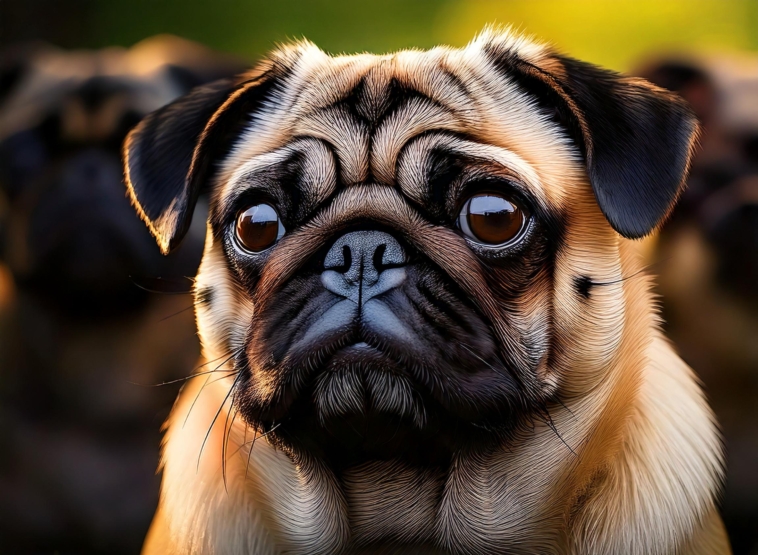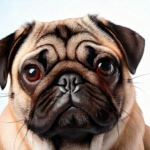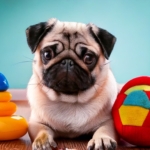Pug Life 101: A Snort-Filled Guide to Raising Your Wrinkly Best Friend
Congratulations! You’ve decided to open your home (and likely your bed) to a pug—a little, squishy, snorting bundle of joy. But beneath that cute face is a dog that needs some serious TLC. Let’s get into taking care of your pug without losing your mind—or your snacks.
Pug Introduction: Welcome to the Wrinkle Club
Pugs are essentially cartoon throw pillows—small, adorable, and constantly judging you with their big brown eyes. Their muscular small bodies, wrinkled faces, and expressive eyes are all part of the complete pug deal.
Pug Facts:
- Weight: Typically 14–18 lbs of solid snuggle energy.
- Coat: Smooth short coat—essentially a fur coat with the shedding of a blizzard.
- Lifespan: Look forward to 12–15 years of snorts, snores, and side-eye.
Why Pugs Are the Couch Potatoes of the Canine World
Pugs are toddlers who never grow up. They’re snuggly, playful, and clueless about personal space.
- Snuggle Monsters: Back-end cuddles, please. More than treats. Almost.
- Low-Energy Athletes: They’ll play fetch precisely three times. Then nap.
- Friend-Makers: Excellent with children, pets, strangers, and likely burglars. Everyone’s a potential lap.
The Not-So-Fun Stuff: Common Pug Health Drama
As cute as they are, pugs are somewhat high-maintenance when it comes to health.
- Breathing Like a Darth Vader Fan Club President: Air is optional with their flat faces. Steer clear of hard exercise and extreme heat.
- Chunky Monkey Syndrome: Food is their love. Perhaps too much. Your new religion is portion control.
- Wrinkle Woes: Cute little folds can trap bacteria and moisture. Time to learn to become a wrinkle cleaning pro.
Setting Up Pug Paradise: Home Edition
If you believe your pug will adjust to your home, don’t. You’re adjusting to theirs.
- Nap Zone: Pugs require a peaceful, cozy spot in which to plot world domination (or nap).
- Pug-Proof Your Home: Take away things they’ll chew on, trip over, or attempt to eat. which is all of it.
- Temperature is Important: These pups heat up quicker than your computer. Run the AC.
- Royal Bedding: Provide them with a plush bed or let them steal yours.
- Hydration Station: Fresh water at all times. Pugs are dramatic if even a little bit thirsty.
- Chew Toys or Bust: Keep their minds occupied and your shoes intact.

Feeding the Beast: Pug Nutrition and Diet Plans
Pugs eat like they haven’t seen food since the Roman Empire. You’ll need to intervene.
- Top-Shelf Dog Food Only: Meat, grains, and veggies. Hold the pizza crusts.
- Portion Patrol: Overfeeding is like giving them a one-way ticket to Chonk Town.
- No Human Snacks: Even if they stare deeply into your soul.
- Smart Snacks: Use carrots and approved treats, not cookies.
- Hydrate Like a Champion: Water bowls should always be full (and not flipped over).
- Meal Schedule: Consistency aids digestion—and restricts the begging.
Training: Because You’re the Boss (In Theory)
Pugs are like teaching a potato with an attitude—but yes, it can be done.
Training Tips:
- Be Consistent: Mixed signals = confusion.
- Use Treats and Praise: They’re more effective than lectures.
- Start with the Basics: “Sit,” “Stay,” “Come,” and “Stop Licking That.”
- Crate Training: Pugs adore snuggly caves—and it keeps them out of trouble.
Socialization:
- Early Exposure: Get them accustomed to noises, odors, and strange humans at an early age.
- Playdates: With a grown-up to watch over, not open play.
- Obedience Classes: Useful for socialization and humiliating anecdotes.
- Park Trips: Good for meeting new people and parading around their finest clothes.
Exercise: The “Just Enough” Philosophy
Pugs are strolls, not sprints.
- Daily Walks: Two 20-minute adventures. No marathons, please.
- Playtime: Backyard zoomies and ball playing indoors.
- Don’t Do the Heat: They’re heat-prone. Like, fainting-on-a-sunny-day prone.
- Puzzle Toys: Engage that brain! Or they’ll use it to plan fridge raids.
- Vet-Recommended Plans: If they’re older or chubbier than average.
Grooming: Because Clean Folds = Happy Pug
Pugs shed like it’s their part-time job, and wrinkles require TLC.
- Brushing: Every other week—or get the “fur blizzard” look.
- Baths: Monthly with can shampoo. Extra points for bubble hats.
- Wrinkle Cleaning: Every day. Don’t you dare skip. Your nose will hate you for it.
- Nails: Trim every 3–4 weeks if you don’t enjoy tap dance symphonies on your floors.
- Dental Care: Brush those teeth. Only dog toothpaste. No surprise minty freshness.
Wellness Tips: Keep That Pug Pumped (Figuratively)
- Watch That Waistline: Obesity = shorter life, more vet bills.
- Clean Those Rolls: Unwashed folds = infection city.
- Oral Hygiene: Bad breath today, dental disaster tomorrow.
- Vaccines: Just do it. No excuses.
- Yearly Checkups: Twice yearly if they’re elder or drama queens (aka all pugs)
Pug-Proofing Your Life: Safety First
Pugs are not delicate, but they are not invincible either. Here is how to protect them:
- Cool Temps Only: Their nemesis is heat. Fans and shade are always a good idea.
- Secure Outdoor Space: No escaping. No holes where they can get hurt. No backyard critters .
- No Toxic Plants: No lilies, no poinsettias, no mystery leaves .
- Furniture Layout: Low and slow. Pugs are not Olympic jumpers.
- Hide Small Stuff: If it can go in their mouth, it’s a choke hazard.
- Child Safety: Lock the bleach away. And the chocolate.
Routine: Because Pugs Love Predictable Chaos
Pugs love routine. They’ll still do what they please, but you’ll be happier.
- Establish Meal Times: On the dot. Ideally in adorable bowls.
- Morning Routine: Potty, breakfast, walk, sniff everything around 100 feet.
- Training Sprints: 5–10 minute sessions keep it fun and successful.
- Nap Time (Required): Rest = happy pug.
- Grooming = Bonding: Daily wrinkle cleanings, nail clipping, tooth scrubbing. You know the routine.
Bad Behavior? Let’s Fix That
Pugs are not flawless. Gasps, we know.
- Identify the Triggers: Noisy sounds? New individuals? Vacuums?
- Reward the Good Stuff: Treats > yelling.
- Exercise More = Less Mayhem: Pug naps = happy pug.
- Social Butterfly Time: New animals and people assist them in relaxing.
- Call the Experts: There are trainers and vets for a reason.
Traveling With Your Pug: Road Snorts Ahead
Pugs adore new locations—if they’re comfortable.
- Verify Hotel Policies: Not everyone adores dog hair like you.
- Essentials Pack: Food, leash, meds, blanket, and squeaky toy of choice.
- Carrier Time: Roomy, ventilated, and no funky odors.
- Frequent Stops: Every 2 hours to stretch, sniff, and pee on objects.
- Stay Cool: Literally. Handheld fans are your new best friend.
- Tag & Chip: In case they get the urge to “explore.”
Fun & Games: Activities That Bring You Closer
Connect with your pug through cleverness and silliness.
- Fetch (Lazy Version): Soft toys only. Torn sofas are unnecessary.
- Puzzle Toys: Keeps them focused and not in the trash can.
- Short Walks: Sniff, walk, repeat.
- Training Sessions: Make them fun, or they’ll ignore you.
- Cuddle Time: Mandatory. Non-negotiable.
- Playdates: Because snorting alone is dull.
Pug Health 101: Know the Usual Suspects
Your pug might be treated like royalty, but they have a medical scroll of doom all their own.
- BOAS (Brachycephalic Airway Syndrome): There’s a whole lot of breathing trouble.
- Obesity: They’ll eat until they burst unless you intervene.
- Skin Allergies: Wash, moisturize, repeat.
- Eye Injuries: Large eyes = lots of bumping and scratching.
Need Help? Don’t Panic – Use These Resources
You’re not alone in this pug-life adventure.
Websites:
- American Kennel Club (AKC): All the basics and more.
- Pug Dog Club of America (PDCA): Pug-specific wisdom.
Books:
- The Pug Handbook by Brenda Belmonte – Your new bedtime read.
- All Pugs: The Pug Owner’s Mouth by Andree Lynse – Real advice from pug people.
Online Communities:
- PugVillage.com: The internet’s wrinkliest forum.
- Facebook Groups: Pug memes, pug advice, pug drama.
Find a Vet:
- Use websites like Vetstreet to locate a vet that knows pugs. and their dramatic flair.
Final Bark:
Pugs are equal measures of joy and chaos, snuggles and snorts. Treat them well, establish a good routine, and be sure to have a good laugh at their absurd antics. Because when you share life with a pug, every day is wacky—in the best sense.




